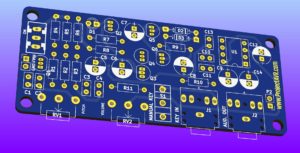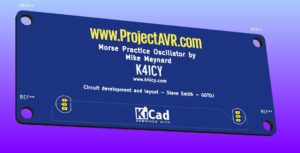I successfully completed the Twin ‘T’ Oscillator, original by Mike Maynard – K4ICY. It’s a great circuit and sounds really good. Much better than a raspy 555 version. Mike has been kind enough to put a link to my project on his website.
I showed my friend Phil G3MGQ who liked the design but suggested a couple of improvements to make it a good project for UK Foundation/Intermediate radio licence students. Phil requested the addition of an LED to facilitate sending Morse Code across a classroom and a microswitch to act as a minature Morse key on board. I have since added these features. I also had a think about how the board was to be used.
Because the boards may be left unboxed, I reasoned that a better placement of the controls and sockets would make for easier operation. I moved the pitch and volume controls over to the left of the board and the sockets to the right. I also added an on board switch on the power input. The microswitch Morse key is in the middle of the board on the front and the LED on the rear of the board with it’s contacts orientated across to facilitate bending over to the vertical. It can also accomodate right-angled LEDs too.
Because the board is intended to be used bare or cased, I also designed a base panel to add so that the contacts underneath are prevented from shorting on any surface it is used on. It’s a blank PCB but KiCad seems not to want to do a copper pour unless there are at least some connections in the design. I put a couple of transistor footprints on the board for this reason. They serve no purpose except to allow the copper pour.
This panel can be added to the oscillator board with standard M3 bolts, with a single nut to separate them. Then four rubber stick on feet can be attached to prevent movement.
This updated design with be added to the Non-AVR Project page once built and proved.


